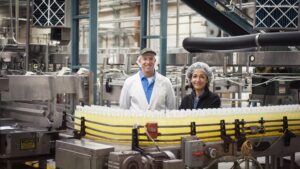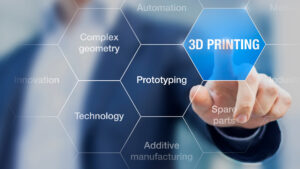Additive manufacturing has arrived at a turning point — not of hype, but of hard questions. No longer a futuristic curiosity, 3D printing is now a strategic tool being shaped by engineers, entrepreneurs, and policymakers alike. Across industries, the shift is unmistakable: major manufacturers are scaling investments, while nimble startups find inventive ways to tap into its transformative potential. But just as the process of additive manufacturing builds layer by layer, so must our understanding of how to fully unlock its value — and what’s standing in the way.
From the promise of AI-optimized designs and distributed production to the pressing realities of regulation, cybersecurity, and workforce gaps, this roundtable brings together a diversity of voices to map both the terrain and the road ahead.
Opportunities
To start things off on a positive note, there’s a lot to be excited about with regards to additive manufacturing. Opportunities in 3D printing exist for virtually every sector, but especially manufacturing, healthcare, and construction. The technology has matured beyond its initial limitations to offer unprecedented design freedom and material efficiency. Here are three promising areas worth focusing on in the years ahead:
Integration with AI – “Vibe Manufacturing”
The integration of AI with additive manufacturing presents unprecedented possibilities. Smart algorithms can optimize design parameters in ways human engineers simply cannot match, reducing material waste. Predictive maintenance systems powered by machine learning can anticipate equipment failures before they occur, potentially saving manufacturers millions in downtime costs. AI-powered waste disposal systems stand to massively cut commercial waste by reducing overall transportation distances by as much as 36.8%.
This evolution mirrors a trend in software development known as “vibe coding,” where AI tools translate natural language into working code. Just as software teams are adjusting to new collaborative workflows with AI, manufacturers are learning to co-create with intelligent systems that extend human creativity and precision.
Meanwhile, AI-enabled generative design tools are revolutionizing product development cycles. What once took months can now be accomplished in days or even hours. Companies like Autodesk report their customers achieving 20-50% weight reduction in parts while maintaining or improving performance specifications.
Distributed Additive Manufacturing
Distributed manufacturing networks represent perhaps the most transformative potential of additive technologies. Rather than centralized production facilities shipping finished goods globally, we’re witnessing the emergence of interconnected printing hubs positioned strategically near end users. This model drastically reduces shipping costs, carbon emissions, and delivery times.
The U.S. Marine Corps has already implemented this approach with their X-FAB (expeditionary fabrication) units, mobile facilities capable of 3D printing replacement parts in forward operating locations. Similarly, companies like SyBridge Technologies and Xometry are building commercial networks of manufacturing partners, creating what amounts to an Airbnb of manufacturing capacity.
Industry experts project an increasingly large portion of finished goods will be produced closer to their final destination tomorrow compared to today. This shift promises not only logistical advantages but also enhanced supply chain resilience against disruptions like those experienced during recent global crises.
Direct Energy Deposition (DED)
Direct Energy Deposition (DED) is being increasingly recognized for its potential in both expanded and new production lines. Jeff Robertson, director of business development at manufacturing giant Hexagon, recently said it’s one of their perceived “brightest spots” and largest areas of focus.
DED works by depositing metal powder or wire directly onto a substrate while simultaneously melting it with a focused energy source like a laser or electron beam. This allows for the creation of large, complex metal components with exceptional structural integrity. The technology excels particularly in repair applications, where damaged parts can be restored rather than replaced, offering significant cost savings for industries like aerospace and defense. According to industry analysts, the DED segment is projected to grow to USD 7.3 billion by 2033, outpacing several other additive manufacturing methods.
Challenges
Despite promising advancements, significant hurdles remain in the full realization of additive manufacturing.
Regulatory Frameworks
Regulatory frameworks always struggle to keep pace amidst technological advancement. Questions about intellectual property protection when AI generates novel designs remain largely unresolved. Who owns an AI-created innovation? The software developer? The manufacturer? These legal gray areas create hesitation among potential adopters.
Updates will come from regulatory bodies like the FDA, FAA, and international standards organizations. These agencies are beginning to develop specialized frameworks for additive manufacturing certification, but progress remains uneven across sectors. The FDA’s guidance on 3D printed medical devices represents a step forward, yet many industries still operate in regulatory uncertainty.
Cross-border considerations further complicate matters. A part designed in Germany, printed in Singapore, and installed in Brazil may encounter three different regulatory environments. This regulatory fragmentation creates significant compliance costs and risks for global manufacturing operations. Industry consortia are advocating for harmonized international standards, but achieving consensus among competing national interests proves challenging.
Data Security
Near-instantaneous, remote, and versatile production is great, but it comes with caveats. Prime among them? Data security. By taking operations digital, organizations expose themselves to new vulnerabilities. The digital files containing proprietary designs become valuable targets for industrial espionage and cybercriminals. A single compromised file could lead to counterfeit production or intellectual property theft on a massive scale.
A 2025 IBM security report recently ranked manufacturing as the top industry targeted by cyberattacks for the third year in a row. The distributed nature of additive manufacturing networks expands the attack surface exponentially. Each node in the network – from design studios to production facilities – represents a potential entry point for malicious actors.
This is an issue that will not only affect progress in embedding 3D printing into the manufacturing industry, but getting Industry 4.0 off the ground as a whole. Businesses will only invest in digital transformation if they believe their intellectual property and operational data remain secure. Yet current efforts may already be working; according to the 2024 Gartner CIO and Technology Executive Survey, 80% of CIOs plan to increase spending on cyber/information security in 2024.
Complex Parts, on Demand
Everyday consumers aren’t alone in wanting unique, one-of-a-kind products. Beyond personalized mugs and keychains, large companies require parts customized for specific machines, particularly challenging operating environments and experimental designs. Only in their case, the final product needs to be commercial grade. Additive manufacturing has the potential to help, but only if deployed in an operationally realistic way.
As of today, several barriers impede wide-scale viability:
Cost Prohibitive Equipment – Industrial-grade 3D printers capable of producing commercial-quality parts can cost anywhere from $100,000 to over $1 million, putting them out of reach for many small to mid-sized manufacturers.
Material Limitations – While the range of printable materials continues to expand, many specialized applications require specific material properties that current additive technologies cannot reliably reproduce.
Production Speed – For high-volume manufacturing scenarios, traditional methods still outpace additive manufacturing by orders of magnitude, creating bottlenecks in supply chains.
Quality Consistency – Ensuring uniform quality across batches remains challenging, with variables like temperature fluctuations and material inconsistencies affecting final product reliability.
Certification Hurdles – Regulatory approval processes for critical components in aerospace, automotive, and medical industries remain lengthy and complex for additively manufactured parts.
Workforce
The shifting landscape of additive manufacturing demands new skill sets from workers. Traditional machining expertise must now be complemented with digital literacy and data analysis capabilities. According to a Deloitte study, 1.9 million manufacturing jobs could go unfilled by 2033 if this and related issues continue to go unaddressed.
Educational institutions are racing to develop curricula that address these needs, but the pace of technological change often outstrips academic program development. Industry-academic partnerships, like those between America Makes and community colleges, offer promising models for workforce development that remain responsive to evolving industry demands.
This mirrors what’s happening in the software world, where engineers are learning to work with AI-powered “vibe coding” tools—rapidly prototyping solutions using natural language inputs. In manufacturing, the equivalent shift means workers must guide, refine, and interpret AI-generated outputs, from part designs to predictive models, while understanding the broader context in which those outputs are applied.
Design for Additive Manufacturing (DfAM)
One of the most pressing educational needs lies in teaching Design for Additive Manufacturing (DfAM) — a discipline that goes far beyond simply exporting a CAD file to a printer. Additive manufacturing enables geometries and internal structures that traditional manufacturing cannot replicate, but to capitalize on that potential, engineers and designers must think differently from the outset.
DfAM training focuses on optimizing part orientation, minimizing support structures, and utilizing topology optimization and generative design. It also includes understanding material behaviors specific to additive processes, such as thermal distortions in metal prints or layer adhesion in polymers. Without this foundational knowledge, companies risk underutilizing their machines or producing subpar parts that fail to deliver on the promise of AM. As DfAM becomes more central to production, expect to see an increased demand for mechanical engineers who are fluent in both design theory and real-world print limitations.
Additive Manufacturing Credential Programs
Recognizing this skills gap, a growing number of credential programs and certifications are emerging to equip the workforce with industry-aligned AM knowledge. Organizations like SME, ASTM International, and America Makes have rolled out tiered certifications that address everything from fundamental machine operation to advanced design strategies and quality assurance in regulated industries.
These credentials offer more than just technical know-how — they signal to employers that workers are equipped to thrive in high-tech, Industry 4.0 environments. For small and mid-sized companies that might not have the resources for on-the-job training, hiring workers with additive credentials is a fast-track solution to building AM capabilities. In the long run, widespread credential adoption may also help harmonize talent pipelines across regions and sectors, providing a shared baseline of additive manufacturing competence.
Project DIAMOnD Academy
Michigan’s Project DIAMOnD, spearheaded by Automation Alley, is a standout example of workforce innovation. Originally launched to distribute 3D printers to small and mid-sized manufacturers across Southeast Michigan, the initiative recently expanded to include a new training component: the Project DIAMOnD Academy.
This academy pairs hands-on learning with cloud-connected production practices, preparing manufacturers to work in real-time distributed networks. Like vibe coding’s emphasis on lowering technical barriers in software development, the DIAMOnD Academy trains participants to approach manufacturing tasks as hybrid human-AI collaborations—turning prompts, data, and feedback into production-ready outputs. With practical training modules and expert-led guidance, the Academy is helping future-proof Michigan’s manufacturing workforce.
Final Thoughts
The road to widespread additive manufacturing isn’t without obstacles — but each challenge is
also an invitation. An invitation to innovate, collaborate, and rethink what’s possible across the entire product lifecycle. Whether it’s reimagining logistics through distributed production, reducing waste through AI-driven design, or cultivating the next generation of digitally fluent workers, the path forward is being forged by those willing to confront complexity head-on. Additive manufacturing is no longer about proving what’s possible — it’s about building what’s next. And the future won’t be built in isolation, but together.
Additive manufacturing isn’t evolving in isolation. Much like software development’s shift toward vibe coding—where human creativity is amplified by AI-generated outputs—the future of making things is becoming faster, more collaborative, and deeply influenced by natural language workflows. Embracing this transformation doesn’t diminish the value of human expertise; it elevates it. The organizations that adapt, reskill, and reimagine their roles in this ecosystem will be the ones that shape its future.










